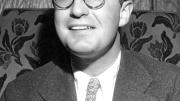Crisscrossing the Middle East, assessing governments and plotting coups over lime rickeys and tennis, “Kim” Roosevelt ’38 led the CIA overthrow of Iran’s first semi-democratic government. Few Americans know this, and that’s how Roosevelt wanted it. The United States is still haunted by the consequences.
In 1953, President Eisenhower had just taken office, pledging to contain Communism. The enemy had seized eastern Europe, won China, invaded South Korea, and exploded an A-bomb. The Central Intelligence Agency was faltering against the Soviet menace.
Roosevelt was its Middle East expert. He spoke neither Arabic nor Farsi, but Theodore Roosevelt’s 37-year-old grandson befriended kings, tribal leaders, and heads of state as easily as he dined at the White House with cousin Franklin and Winston Churchill. He had served in the Office of Strategic Services (the CIA’s World War II predecessor) in Cairo before participating in the Allied invasion of Italy; he also visited the Levant and Iran. Postwar experience in the region led to a book, Arabs, Oil, and History. When he joined the CIA in 1950, his task was to damage the Soviet sphere of influence.
Opportunity arose in Iran. Prime minister Mohammed Mossadegh, an elderly lawyer with ulcers who often conducted business in his pajamas and wept in public, was a secular democrat who had nationalized Iran’s oil industry in 1951. The infuriated British government--whose entrepreneurs had located and developed the oil reserves, then the world’s largest--drew up plans to invade.
Britain also sought U.S. help for a coup, warning that Iran could fall to the Communists. In the Cold War atmosphere, U.S. policymakers ignored a national intelligence estimate that concluded that Iran’s fractious Communist party was incapable of a takeover in the near term. (“The American intelligence in the field got it right, but as the intelligence moved up the ladder, officials read into it what they wanted to justify a coup,” says the historian Maziar Behrooz.) Secretary of State John Foster Dulles called Mossadegh a “madman” who had to go in order to safeguard the Persian Gulf for oil exports and prevent a Communist takeover.
Initially, Eisenhower disagreed and declared Mossadegh “the only hope for the West in Iran.” But as British operatives laid the groundwork for a coup, bribing key Mossadegh allies, arranging the murder of Tehran’s police chief, and fomenting riots to create the appearance of rising unrest, the president approved a joint U.K.-U.S. coup--the U.S. government’s first regime change.
Roosevelt slipped back into Iran in July 1953. He meshed Britain’s networks with his own and manipulated public opinion: local newspapers soon accused the Iranian leader of being corrupt and pro-Communist. CIA-paid rioters demanded his resignation. To induce Mohammad Reza Shah Pahlavi to dismiss Mossadegh, Roosevelt had himself smuggled into the royal palace for midnight talks. A CIA colleague who spent hours watching Roosevelt persuade governments and Arab agents to take risks for the United States throughout the Middle East recalled, “He spoke as if he’d just had a conversation with the [U.S.] president.” Historian Ervand Abrahamian says, “Roosevelt told the shah the U.S. would support a new government.…He believed Roosevelt. Why? He was a Roosevelt.”
Still, the shah dallied while the usually confident Roosevelt sweated it out in hiding--smoking, swimming, and listening to “Luck Be A Lady.” When the shah finally did order Mossadegh’s removal, the plot leaked and the shah fled Iran.
Roosevelt then improvised a new coup, bribing army officers with hundreds of thousands of dollars, as he gleefully recounted in his memoir, Countercoup. He helped circulate a story that the shah had fled because Mossadegh tried to seize his throne. When Roosevelt’s Iranian agents called a second coup attempt too dangerous, he used bribery and death threats to gain their obedience. CIA money may have attracted even the religious leader Ayatollah Kashani, a former Mossadegh ally and speaker of the assembly. After two days of street battles, tank units defeated the troops protecting Mossadegh. Several hundred people died in the turmoil. On August 22, the shah reclaimed power: “the beginning of a 10-year period in which the U.S. undertook to remake Iran and place it firmly in the Western camp in the Cold War,” says a leading scholar of the coup, Mark Gasiorowski. In 1954, Eisenhower secretly awarded Roosevelt the National Security Medal. With the coup, the United States gained 40 percent of Iran’s oil production and leadership in the Middle East for a quarter-century, until the blowback: the 1979 revolution that toppled the shah.
Roosevelt’s encores met mixed success: the CIA aided Egypt’s Gamal Abdel Nasser, then plotted to overthrow him; a coup Roosevelt fomented in Syria in 1957, led by another agent, failed spectacularly. He left the CIA in 1958 to work for American oil and defense firms, often visiting former operatives, and the shah, in Iran.
The U.S. government didn’t acknowledge the coup until the year Roosevelt died. Just before the New York Times published a leaked CIA history in April 2000, Secretary of State Madeleine Albright admitted: “The coup was clearly a setback for Iran’s political development. And it is easy to see why many Iranians continue to resent the intervention by America in their internal affairs.” Roosevelt had already provided an assessment of his own for his fiftieth-reunion report: “I have had a satisfactory, often exciting life, of which I am appropriately proud.”








